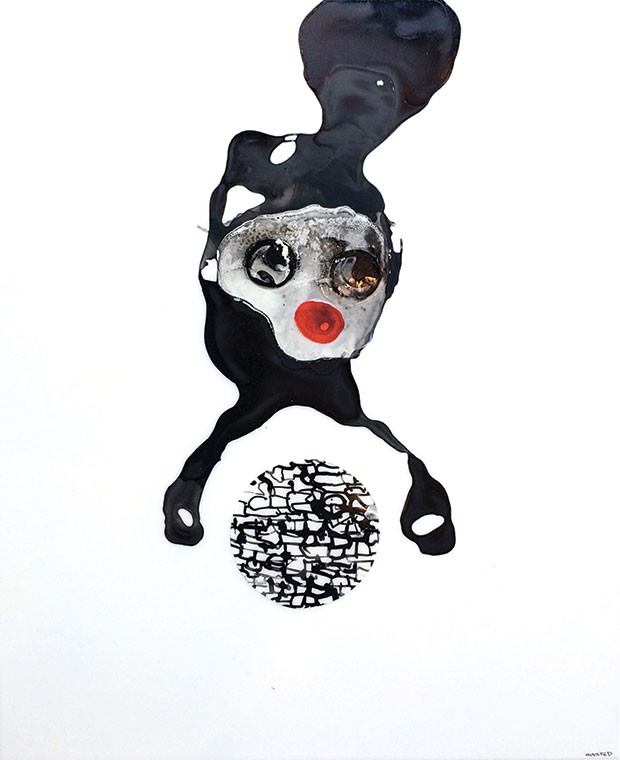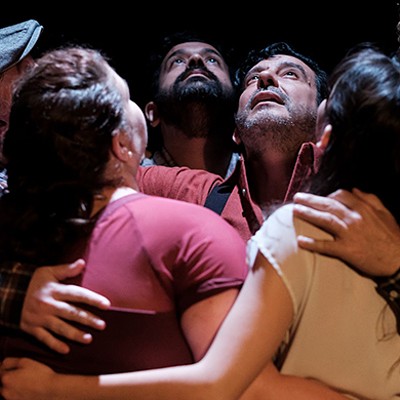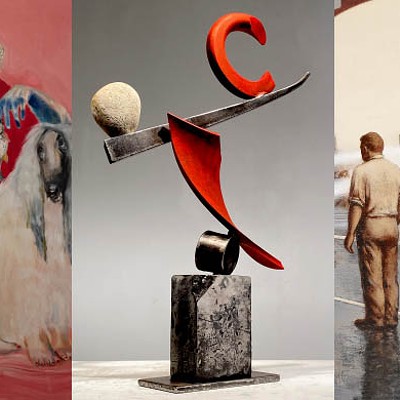Jackie Hoysted explores belonging at BoxHeart
Hoysted simultaneously excites a detail-driven brain and massages a grief-stricken heart

Jackie Hoysted’s painting “Kiss These Secret Stones”
JACKIE HOYSTED: CONFLICTED
continues through Fri., March 24. BoxHeart Gallery, 4523 Liberty Ave., Bloomfield. 412-687-8858 or boxheart.org
BoxHeart Gallery is a wonderland on a Sunday afternoon, part boutique and part gallery. Living-room furniture decorates the entrance, easing visitors into the intimate and compelling body of work by Irish-born, Maryland-based multimedia artist Jackie Hoysted. Conflicted fits well on the first floor of BoxHeart, embracing all of what this gallery’s mission craves: “tragic and wonderful realities.” Ironically, Conflicted, an ardent exploration of belonging, is perfectly at home here.
Hoysted’s focus and skill are notable in individual pieces, and thrilling in the context of the complete exhibition. Hoysted communicates complex emotional histories in her acute self-portraiture by use of visual motifs: limiting subjects to head and shoulders; a solitary line to substitute for the backbone or the rest of the body; black and white palettes with splashes of color; and poignant titles referencing Gaelic myth or Irish localisms. “Medb Doth Spilleth Over” differs, as the face is more defined, and the use of green deftly references the Celtic mother goddess.
Hoysted continuously examines nostalgia: Does she feel blessed or cheated? “Sorrow” and “Liberty” are similar in style and in portrait outline to the others, except for the backbone line, which looks like it’s full of musical notes. The angle of that line is usually perpendicular to the bottom of the page, but it’s parallel in “Liberty” and diagonal in “Sorrow.” Hoysted creates her own set of rules, then breaks them. This choice has a distinct emotional effect.
Exceedingly deliberate, her construction method mirrors her conceptual processes. She paints on Dura-lar, a translucent, protective covering used for drafting. This slippery, malabsorptive surface sometimes causes her colors to run together. The technique takes patience, and the paint takes a long time to dry. In “Frail,” the precise delicacy in one blob of paint transforms it into the subtle dangling of a collarbone.
Hoysted simultaneously manages to excite a detail-driven brain and massage a grief-stricken heart. Hoysted confronts big questions. “Identity,” on black arches paper, is the most efficient of her larger pieces. Are we nothing more than a collection of patterns, motifs repeated over and over? Without an outline to our form, what keeps us from floating or melting away? Throughout this show, nothing is resolved, but it feels like Hoysted’s getting closer to something. Homing in.
Hoysted’s focus and skill are notable in individual pieces, and thrilling in the context of the complete exhibition. Hoysted communicates complex emotional histories in her acute self-portraiture by use of visual motifs: limiting subjects to head and shoulders; a solitary line to substitute for the backbone or the rest of the body; black and white palettes with splashes of color; and poignant titles referencing Gaelic myth or Irish localisms. “Medb Doth Spilleth Over” differs, as the face is more defined, and the use of green deftly references the Celtic mother goddess.
Hoysted continuously examines nostalgia: Does she feel blessed or cheated? “Sorrow” and “Liberty” are similar in style and in portrait outline to the others, except for the backbone line, which looks like it’s full of musical notes. The angle of that line is usually perpendicular to the bottom of the page, but it’s parallel in “Liberty” and diagonal in “Sorrow.” Hoysted creates her own set of rules, then breaks them. This choice has a distinct emotional effect.
Exceedingly deliberate, her construction method mirrors her conceptual processes. She paints on Dura-lar, a translucent, protective covering used for drafting. This slippery, malabsorptive surface sometimes causes her colors to run together. The technique takes patience, and the paint takes a long time to dry. In “Frail,” the precise delicacy in one blob of paint transforms it into the subtle dangling of a collarbone.
Hoysted simultaneously manages to excite a detail-driven brain and massage a grief-stricken heart. Hoysted confronts big questions. “Identity,” on black arches paper, is the most efficient of her larger pieces. Are we nothing more than a collection of patterns, motifs repeated over and over? Without an outline to our form, what keeps us from floating or melting away? Throughout this show, nothing is resolved, but it feels like Hoysted’s getting closer to something. Homing in.


















